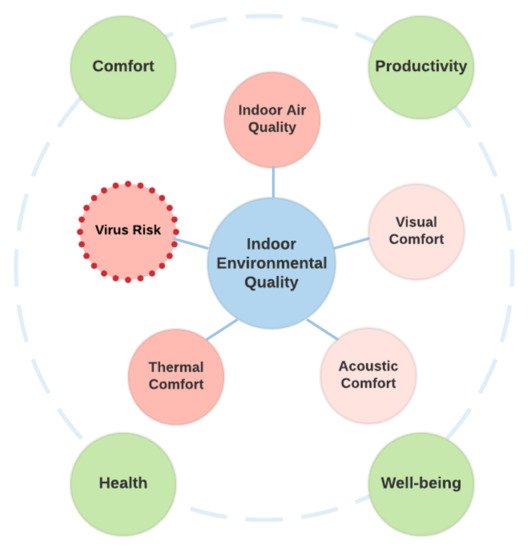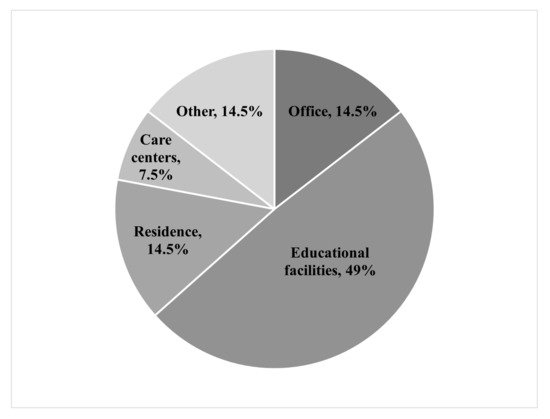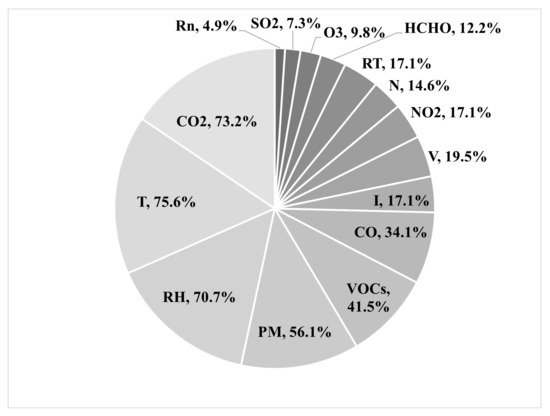You're using an outdated browser. Please upgrade to a modern browser for the best experience.

Submitted Successfully!
Thank you for your contribution! You can also upload a video entry or images related to this topic.
For video creation, please contact our Academic Video Service.
| Version | Summary | Created by | Modification | Content Size | Created at | Operation |
|---|---|---|---|---|---|---|
| 1 | Michalis Michaelides | + 1257 word(s) | 1257 | 2022-02-10 07:28:36 | | | |
| 2 | Camila Xu | -1 word(s) | 1256 | 2022-02-16 09:24:28 | | | | |
| 3 | Camila Xu | -12 word(s) | 1244 | 2022-02-16 09:30:58 | | |
Video Upload Options
We provide professional Academic Video Service to translate complex research into visually appealing presentations. Would you like to try it?
Cite
If you have any further questions, please contact Encyclopedia Editorial Office.
Michaelides, M. Field Measurement Studies on Indoor Air Quality. Encyclopedia. Available online: https://encyclopedia.pub/entry/19490 (accessed on 31 December 2025).
Michaelides M. Field Measurement Studies on Indoor Air Quality. Encyclopedia. Available at: https://encyclopedia.pub/entry/19490. Accessed December 31, 2025.
Michaelides, Michalis. "Field Measurement Studies on Indoor Air Quality" Encyclopedia, https://encyclopedia.pub/entry/19490 (accessed December 31, 2025).
Michaelides, M. (2022, February 16). Field Measurement Studies on Indoor Air Quality. In Encyclopedia. https://encyclopedia.pub/entry/19490
Michaelides, Michalis. "Field Measurement Studies on Indoor Air Quality." Encyclopedia. Web. 16 February, 2022.
Copy Citation
The Indoor Air Quality (IAQ) is one of the key factors that influence the quality of the indoor environment, as well as the human health.
indoor environmental quality
thermal comfort
indoor air quality
1. Introduction
According to recent studies, people nowadays spend most of their lifetime indoors [1]. Undoubtedly, the Indoor Air Quality (IAQ) is one of the key factors that influence the quality of the indoor environment, as well as the human health [2]. Various health problems have long been known to arise from poor IAQ, with the most severe ones to include lung cancer, carbon monoxide poisoning, pneumonia, asthma, and various allergies [3]. In fact, household air pollution was the main cause for 3.8 million deaths according to the World Health Organization (WHO), which corresponds to 7.7% of the worldwide mortality in 2016 [4]. Note that household fuel combustion is a key contributor for indoor air pollution, especially in developing countries, where the cooking and heating primarily rely on solid fuels including wood, charcoal, and crop waste [5]. The recent lock-downs due to the current COVID-19 pandemic forced most people to work remotely from their homes and has highlighted more than ever before the importance of Indoor Environmental Quality (IEQ) monitoring.
All environmental aspects have a massive impact on the quality of people’s lives [6]. Inadequate ventilation and poor IAQ are the key contributors to the Sick Building Syndrome (SBS) [7] which considerably influences the human health and workers productivity. In the United Kingdom and the United States, it is estimated that the State loses roughly 15 billion pounds and 38 billion dollars, respectively, due to reduced productivity of workers and illnesses caused by inadequate supply of fresh air alone [8]. In fact, a workplace with high IEQ obviously improves the workers’ health and mood, thereby increasing their productivity and plays a crucial role on the profitability of businesses. Generally, investing on improving IEQ in workplaces is characterized by a short pay back period and generates additional monetary returns thereafter [9]. Studies on the quality of IEQ among students have shown that inadequately set parameters can have a drastic impact on students’ cognitive abilities [10]. It should be noted that buildings being rated as “sustainable and green” do not truly guarantee their compliance with the desired IEQ level [11][12][13][14]. Hence, the stringent need to build NZEB (Nearly Zero Energy Buildings) [15][16][17], whose design requires a holistic approach based upon the principles of sustainability, should also focus on ensuring IEQ while designing new buildings, as well as when retrofitting old ones. The need to include IEQ in the building design has also been identified over the last two decades by various green building certification systems, such as the Building Research Establishment Environmental Assessment Method (BREEAM) from the UK, Green Star from Australia, and Leadership in Energy and Environmental Design (LEED) from the US [18][19][20].
The quality of an indoor space in relation to the health, comfort, well-being, and productivity of occupants forms the IEQ. The concept of IEQ is very broad and depends on many variables such as temperature, relative humidity, air velocity, air flow, occupancy, concentration of pollutants, noise and lighting. These are commonly grouped into four major areas [21] that define the quality of the environment inside a space, namely: (i) Indoor Air Quality (IAQ) [22], (ii) Thermal Comfort [23], (iii) Acoustic Comfort [24][25][26], and (iv) Visual Comfort [27][28], as depicted in Figure 1. As shown in the Figure, we additionally propose that (v) Virus Risk, also becomes an essential IEQ pillar. The subject of airborne viruses has been extensively investigated by various research communities in the last two decades. Experimental studies on the presence of virus in air samples are carried out mainly under controlled laboratory conditions. The impact of environmental parameters (e.g., temperature, humidity) on airborne viruses has been also explored, but it still not clear due to the complexities involved. Regarding the estimation of the probability of virus transmission indoors, a number of risk assessment models have been proposed for this purpose. However, only a limited number of IEQ field measurement studies so far have considered the use of real environmental measurements for computing the airborne virus risk.

Figure 1. Typical influencing factors of the IEQ.
IEQ evaluation depends on numerous factors that can be subdivided into four categories: external conditions (temperature, air pollution, noise, sun and natural lighting, green environment), building (enclosure, construction material, furniture), building services (HVAC systems, lighting) and human activities (HVAC use, cleaning, use of paints, varnishes, and glues) [29]. The assessment of IEQ is mainly performed by two approaches, Post-Occupancy Evaluations (POE) and field measurements [9]. In the case of POE, a subjective assessment of the IEQ is performed based on data collected using occupants’ questionnaires. In the latter case, an objective assessment of IEQ is performed using data collected by instruments (i.e., sensing devices, portable loggers or passive samplers). Data acquired by both field measurements and occupants’ questionnaires can contribute towards a more accurate and comprehensive analysis of the indoor environment as perceived by the occupants. To achieve a complete and reliable characterization of thermal comfort and IAQ levels in the built environments and related energy needs, several challenging issues must be addressed with regard to properly designing measurement campaigns (not only from technical and operational perspectives, but also by managing psychological and physiological issues) and effectively elaborating huge amounts of field data.
2. Building Type
Figure 2 illustrates statistics on the type of built environment for the 41 selected field measurement studies. From the plot, it becomes evident that the majority of field studies were conducted in Educational facilities with a percentage of approximately 49%, followed by Offices and Residences, both with 14.5%, Care centers with 7.5%, while the remaining 14.5% were either conducted in a combination of the aforementioned built environments, or in other types of buildings. It is worth pointing out, that educational facilities are characterized by high levels of occupancy, the young age of occupants, the long duration and the weekly consistency of activities from the same occupants; characteristics which render them ideal environments for such controlled field studies. It is evident however, that a very limited number of field measurement studies exist for other types of indoor environments, such as gyms, hospitals, shopping malls and train stations. Such environments are also of high interest since they exhibit a high number of occupants daily both in terms of staff and visitors with various types of activities and could significantly contribute to the understanding of the impact of poor IEQ.

Figure 2. Building type statistics for the selected field measurement studies.
3. Measured Parameters
Figure 3 illustrates the percentage of the studies considering each measured parameter. It is evident that the most common parameters measured in the considered field studies are T and CO2 with 75.6% and 73.2% of the field studies, respectively, followed by RH with 70.7% of the field studies, PM with 56.1% and VOC with 41.5%. On the other hand, the least common parameters are Rn which is considered in just 4.9% of the field studies, SO2 with 7.3% of the field studies, O3 with 9.8%, HCHO with 12.2%; while RT, N, and NO2 were considered in 17.1%, 14.6% and 17.1% of the field studies, respectively. Interestingly, one of the most harmful gases, i.e., radon (Rn), is at the same time the least studied parameter throughout the presented studies. However, one of the largest studies presented in [30] that considers 319 classrooms from 115 schools in Europe has already identified that Rn levels were above recommended in the majority of the field sites. One could thus argue that Rn monitoring and the understanding of its impact in our daily lives is still an under-investigated problem.

Figure 3. Measured parameter statistics for the selected field measurement studies.
References
- Schweizer, C.; Edwards, R.D.; Bayer-Oglesby, L.; Gauderman, W.J.; Ilacqua, V.; Jantunen, M.J.; Lai, H.K.; Nieuwenhuijsen, M.; Künzli, N. Indoor time–microenvironment–activity patterns in seven regions of Europe. J. Expo. Sci. Environ. Epidemiol. 2007, 17, 170–181.
- Cincinelli, A.; Martellini, T. Indoor air quality and health. Int. J. Environ. Res. Public Health 2017, 14, 1286.
- Persily, A.K.; Emmerich, S.J. Indoor air quality in sustainable, energy efficient buildings. Hvac&R Res. 2012, 18, 4–20.
- World Health Organization (WHO). Household Air Pollution. Available online: https://www.who.int/data/gho/data/themes/topics/topic-details/GHO/household-air-pollution (accessed on 6 September 2021).
- Chafe, Z.A.; Brauer, M.; Klimont, Z.; Van Dingenen, R.; Mehta, S.; Rao, S.; Riahi, K.; Dentener, F.; Smith, K.R. Household cooking with solid fuels contributes to ambient PM2. 5 air pollution and the burden of disease. Environ. Health Perspect. 2014, 122, 1314–1320.
- Woo, J.M.; Postolache, T.T. The impact of work environment on mood disorders and suicide: Evidence and implications. Int. J. Disabil. Hum. Dev. 2008, 7, 185–200.
- Burge, P.S. Sick building syndrome. Occup. Environ. Med. 2004, 61, 185–190.
- Fisk, W.J.; Black, D.; Brunner, G. Changing ventilation rates in US offices: Implications for health, work performance, energy, and associated economics. Build. Environ. 2012, 47, 368–372.
- Chapter Introductory Chapter: Indoor Environmental Quality. In Muhammad Abdul Mujeebu; Intech Open: London, UK, 2019; pp. 1–13.
- Shan, X.; Melina, A.N.; Yang, E.H. Impact of indoor environmental quality on students’ wellbeing and performance in educational building through life cycle costing perspective. J. Clean. Prod. 2018, 204, 298–309.
- Spengler, J.D.; Chen, Q. Indoor air quality factors in designing a healthy building. Annu. Rev. Energy Environ. 2000, 25, 567–600.
- Altomonte, S.; Saadouni, S.; Kent, M.G.; Schiavon, S. Satisfaction with indoor environmental quality in BREEAM and non-BREEAM certified office buildings. Archit. Sci. Rev. 2017, 60, 343–355.
- Steinemann, A.; Wargocki, P.; Rismanchi, B. Ten questions concerning green buildings and indoor air quality. Build. Environ. 2017, 112, 351–358.
- Holmgren, M.; Kabanshi, A.; Sörqvist, P. Occupant perception of “green” buildings: Distinguishing physical and psychological factors. Build. Environ. 2017, 114, 140–147.
- Crawley, D.; Pless, S.; Torcellini, P. Getting to net zero. ASHRAE J. 2009, 51, 18.
- Becchio, C.; Bottero, M.; Corgnati, S.; Ghiglione, C. nZEB design: Challenging between energy and economic targets. Energy Procedia 2015, 78, 2070–2075.
- Chastas, P.; Theodosiou, T.; Bikas, D. Embodied energy in residential buildings-towards the nearly zero energy building: A literature review. Build. Environ. 2016, 105, 267–282.
- BREEAM. BREEAM—Sustainability Assessment Method. Available online: https://www.breeam.com/ (accessed on 10 September 2021).
- LEED. LEED Rating System. Available online: https://www.usgbc.org/leed (accessed on 10 September 2021).
- GreenStar. Exploring Green Star. Available online: https://new.gbca.org.au/green-star/exploring-green-star/ (accessed on 10 September 2021).
- Franchimon, F.; Dijken, F.; Pernot, C.; van Bronswijk, J. Air-exchange rate under debate. In Proceedings of the 9th International Conference and Exhibition—Healthy Buildings 2009, HB 2009, Syracuse, NY, USA, 13–17 September 2009.
- Tran, V.V.; Park, D.; Lee, Y.C. Indoor air pollution, related human diseases, and recent trends in the control and improvement of indoor air quality. Int. J. Environ. Res. Public Health 2020, 17, 2927.
- ANSI/ASHRAE Standard 55-2020Thermal Environmental Conditions for Human Occupancy, ASHRAE: Atlanta, GA, USA, 2021.
- Astolfi, A.; Pellerey, F. Subjective and objective assessment of acoustical and overall environmental quality in secondary school classrooms. J. Acoust. Soc. Am. 2008, 123, 163–173.
- Puglisi, G.; Cutiva, L.C.; Pavese, L.; Castellana, A.; Bona, M.; Fasolis, S.; Lorenzatti, V.; Carullo, A.; Burdorf, A.; Bronuzzi, F.; et al. Acoustic comfort in high-school classrooms for students and teachers. Energy Procedia 2015, 78, 3096–3101.
- Montiel, I.; Mayoral, A.M.; Navarro Pedreño, J.; Maiques, S. Acoustic comfort in learning spaces: Moving towards sustainable development goals. Sustainability 2019, 11, 3573.
- Galasiu, A.D.; Veitch, J.A. Occupant preferences and satisfaction with the luminous environment and control systems in daylit offices: A literature review. Energy Build. 2006, 38, 728–742.
- British Standard Institution. BS EN 12464-1:2021 Light and Lighting. Lighting of Work Places Indoor Work Places. Available online: https://www.en-standard.eu/bs-en-12464-1-2021-light-and-lighting-lighting-of-work-places-indoor-work-places/ (accessed on 10 September 2021).
- Almeida, R.M.; De Freitas, V.P.; Delgado, J.M. School Buildings Rehabilitation: Indoor Environmental Quality and Enclosure Optimization; Springer: Berlin/Heidelberg, Germany, 2015.
- Baloch, R.M.; Maesano, C.N.; Christoffersen, J.; Banerjee, S.; Gabriel, M.; Csobod, É.; de Oliveira Fernandes, E.; Annesi-Maesano, I.; Szuppinger, P.; Prokai, R.; et al. Indoor air pollution, physical and comfort parameters related to schoolchildren’s health: Data from the European SINPHONIE study. Sci. Total Environ. 2020, 739, 139870.
More
Information
Subjects:
Engineering, Electrical & Electronic; Computer Science, Information Systems; Environmental Sciences
Contributor
MDPI registered users' name will be linked to their SciProfiles pages. To register with us, please refer to https://encyclopedia.pub/register
:
View Times:
1.6K
Entry Collection:
Environmental Sciences
Revisions:
3 times
(View History)
Update Date:
16 Feb 2022
Notice
You are not a member of the advisory board for this topic. If you want to update advisory board member profile, please contact office@encyclopedia.pub.
OK
Confirm
Only members of the Encyclopedia advisory board for this topic are allowed to note entries. Would you like to become an advisory board member of the Encyclopedia?
Yes
No
${ textCharacter }/${ maxCharacter }
Submit
Cancel
Back
Comments
${ item }
|
More
No more~
There is no comment~
${ textCharacter }/${ maxCharacter }
Submit
Cancel
${ selectedItem.replyTextCharacter }/${ selectedItem.replyMaxCharacter }
Submit
Cancel
Confirm
Are you sure to Delete?
Yes
No




